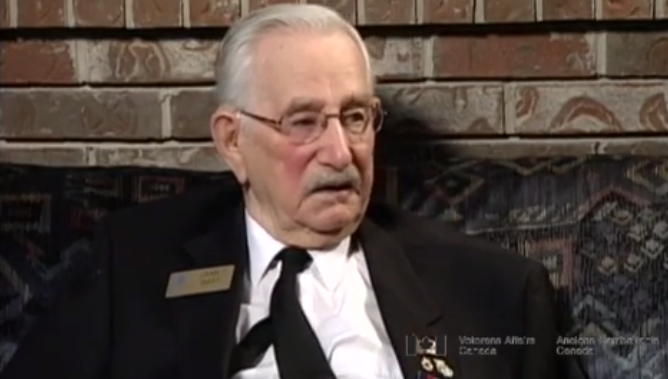Anyhow, then we, we came to New Brunswick,
and we discharged after we left Guantanamo Bay. We discharged
our sugar and we went to Walton, Nova Scotia, and we loaded
(inaudible) for Trinidad again. So, love and behold, we, when
we finished cargo loading, we, we proceeded to New York
to pick up a convoy and, of course, when, when we passed over
the degaussing gear range in New York, they told us our
degaussing gear was defective so we would have to get it repaired
So, we went up to Hudson River and anchored there and, of course,
there was a big barge coming tied on to us, you know, we weren't
that big a ship, you know. So, anyhow, the mate he, he had,
he said, "We'll put two anchors down." And, and we put the
devil's claws on, you know, the anchors, ‘cause he said, it's too
much strain on the wind was . . . So, anyhow, that was alright.
So, that during the night, don't you suppose there was another
ship came in and he, he clipped us, he drifted down on us and
knocked the bow off. So, we had to go to dry dock there then and
after dry dock, we started out again into convoy for the
West Indies, and we dropped out the convoys - never stayed in...
So, the skipper and the chief engineer, they said it
was bad coal from Nova Scotia, from Sydney, Nova Scotia,
can't keep up steam. So, anyhow we took the stragglers route to,
to Norfolk, and we was anchored there, and we got in there in
sometime early in the morning, anchored. Don't you suppose
another ship come up and ran into us again.
Interviewer: They didn't kind of like you, did they?
Oh, my gosh. I'm going to tell you. So, anyhow, then we were in
trouble again. We had to go to the, to the dry dock. So, they
took the coal off of us, our bunkers. And the meantime,
the wireless operator and myself was, was notified you know,
secrecy, that, the, the FBI wanted to see us, you know,
but not to tell anyone, any movements at all on the ship.
So, anyhow, we went and we . . . FBI seen us, and he said, asked
us, he said, "Do you see anything going on, you know,
or anything?" And, and you know we couldn't . . . Only thing
I told him, I said, "Well," I said, "when me and the wireless
operator, the only place we could do where we wouldn't see over
the ocean was down in the well deck." You know, on the after
deck, and we'd be doing the Morse code there, trying to become
more efficient, you know. So, anyhow, the old chief engineer
was always watching us, every move, so the wireless operator,
you know, he said to me, he said, "That chief engineer," he said,
I don't, I, I don't like to see him around." You know, something
like that. He was not in the same opinion, you know, as I was.
Well, I said, "I don't know." So, anyhow, we retold our,
our feeling, or what we saw, you know, to the FBI, and they said,
"That's alright." But he said, "What we're doing... " I don't
know why they told us that, but he must have trusted us,
so he said, "We're taking the coal out, and we're putting it in
box cars and when you're ready to sail again, the same coal is
going back into your ship." So, anyhow, that was fine.
In the meantime, meantime, the, the Canadian National Steamships
transferred me to Park Steamship, to Crescent Park. So, anyhow,
I understood then the ships sailed. They give her a stragglers
route down to Key West. So, anyhow, I guess down there they,
they, they watched all the movements and everything else and,
and I guess she was keeping up her speed and stuff like that.
And, anyhow, I guess they, they, they said, you know, oh,
they said, the coal was much better, and stuff like that.
So, I understood now, I'm not positive sure, but they
said that they were interned, both the chief engineer and the
master. Now, I couldn't say because I never seen, I never seen
nor ran there afterwards or, you know, known anything about it.
During the wartime, that's everything was mum.
You never questioned anything or said anything.



